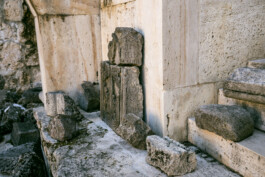Letters Woven in Light: The Armenian Alphabet and its Legacy
Armenia, 2025
The Armenian alphabet is one of the world’s oldest and most distinctive writing systems, created in the early 5th century to meet the linguistic, cultural, and spiritual needs of the Armenian people. It was developed around 405 AD by Mesrop Mashtots, a monk, theologian, and linguist, during a time when Armenia was under foreign cultural and political influence.
The primary motivation behind the creation of the Armenian script was to translate the Bible into Armenian and to foster literacy, education, and a strong sense of national identity. Prior to this, Armenians relied on foreign alphabets such as Greek and Syriac, which were ill-suited to accurately represent the unique sounds of the Armenian language. Recognizing this challenge, Mashtots devised a new alphabet that perfectly aligned with Armenian phonetics. His work was supported by the Armenian Church and the royal court, marking a turning point in Armenian history.
Beyond serving as a writing system, the Armenian alphabet has become a profound national symbol. It is celebrated through literature, education, art, and public monuments both in Armenia and across the global Armenian diaspora. In recognition of its enduring cultural significance, Armenian letter art and its creative expressions were inscribed in 2019 on UNESCO’s Representative List of the Intangible Cultural Heritage of Humanity. This recognition was granted during the 14th Session of the UNESCO Intangible Cultural Heritage Committee, held in Bogotá, Colombia, from 2019.









Letters Woven in Light: The Armenian Alphabet and its Legacy
Armenia, 2025
The Armenian alphabet is one of the world’s oldest and most distinctive writing systems, created in the early 5th century to meet the linguistic, cultural, and spiritual needs of the Armenian people. It was developed around 405 AD by Mesrop Mashtots, a monk, theologian, and linguist, during a time when Armenia was under foreign cultural and political influence.
The primary motivation behind the creation of the Armenian script was to translate the Bible into Armenian and to foster literacy, education, and a strong sense of national identity. Prior to this, Armenians relied on foreign alphabets such as Greek and Syriac, which were ill-suited to accurately represent the unique sounds of the Armenian language. Recognizing this challenge, Mashtots devised a new alphabet that perfectly aligned with Armenian phonetics. His work was supported by the Armenian Church and the royal court, marking a turning point in Armenian history.
Beyond serving as a writing system, the Armenian alphabet has become a profound national symbol. It is celebrated through literature, education, art, and public monuments both in Armenia and across the global Armenian diaspora. In recognition of its enduring cultural significance, Armenian letter art and its creative expressions were inscribed in 2019 on UNESCO’s Representative List of the Intangible Cultural Heritage of Humanity. This recognition was granted during the 14th Session of the UNESCO Intangible Cultural Heritage Committee, held in Bogotá, Colombia, from 2019.








